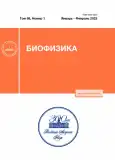Paracrine effects of stem cell conditioned medium on production of oxygen reactive species in blood neutrophils in acetaminophen-induced liver failure
- Authors: Temnov A.A1,2, Sklifas A.N1, Zhalimov V.K1, Sharapov M.G1, Fadeev R.S3, Kobyakova M.I3, Kukushkin N.I1, Rogov K.A4
-
Affiliations:
- Institute of Cell Biophysics, Russian Academy of Sciences
- Moscow Institute of Physics and Technology
- Institute of Theoretical and Experimental Biophysics, Russian Academy of Sciences
- Research Institute of Human Morphology
- Issue: Vol 68, No 1 (2023)
- Pages: 87-97
- Section: Articles
- URL: https://journals.rcsi.science/0006-3029/article/view/144407
- DOI: https://doi.org/10.31857/S000630292301009X
- EDN: https://elibrary.ru/OAFUWG
- ID: 144407
Cite item
Full Text
Abstract
Keywords
About the authors
A. A Temnov
Institute of Cell Biophysics, Russian Academy of Sciences;Moscow Institute of Physics and TechnologyPushchino, Moscow Region, Russia, Dolgoprudny, Moscow Region, Russia
A. N Sklifas
Institute of Cell Biophysics, Russian Academy of SciencesPushchino, Moscow Region, Russia, Dolgoprudny, Moscow Region, Russia
V. K Zhalimov
Institute of Cell Biophysics, Russian Academy of SciencesPushchino, Moscow Region, Russia, Dolgoprudny, Moscow Region, Russia
M. G Sharapov
Institute of Cell Biophysics, Russian Academy of SciencesPushchino, Moscow Region, Russia, Dolgoprudny, Moscow Region, Russia
R. S Fadeev
Institute of Theoretical and Experimental Biophysics, Russian Academy of SciencesPushchino, Moscow Region, Russia
M. I Kobyakova
Institute of Theoretical and Experimental Biophysics, Russian Academy of SciencesPushchino, Moscow Region, Russia
N. I Kukushkin
Institute of Cell Biophysics, Russian Academy of Sciences
Email: nikukushkin@mail.ru
Pushchino, Moscow Region, Russia, Dolgoprudny, Moscow Region, Russia
K. A Rogov
Research Institute of Human MorphologyMoscow, Russia
References
- A. M. Larson, Clin. Liver Dis., 11, 525 (2007).
- M. R. McGill, M. R. Sharpe, C. D. Williams, et al., J. Clin. Invest., 122, 1574 (2012).
- H. Jaeschke, C. D. Williams, A. Ramachandran, et al., Liver Int., 32, 8 (2012).
- Y. Ishida, T. Kondo, A. Kimura, et al., Eur. J. Immunol., 36, 1028 (2006).
- Z. X. Liu, D. Han, B. Gunawan, et al., Hepatology, 43, 1220 (2006).
- P. E. Marques, S. S. Amaral, D. A. Pires, et al., Hepatology, 56, 1971 (2012).
- C. Cover, J. Liu, A. Farhood, et al., Toxicol. Appl. Pharmacol., 216, 98 (2006).
- H. S. Hou, C. L. Liao, H. K. Sytwu, et al., PLoS One, 7, e44880 (2012).
- J. A. Lawson, A. Farhood, R. D. Hopper, et al., Toxicol. Sci., 54, 509 (2000).
- C. D. Williams, M. L. Bajt, A. Farhood, et al., Liver Int., 30, 1280 (2010).
- C. D. Williams, M. L. Bajt, M. R. Sharpe, et al., Toxicol. Appl. Pharmacol., 275 (2), 122 (2014).
- C. D. Williams, A. Farhood, and H. Jaeschke, Toxicol. Appl. Pharmacol., 247, 169 (2010).
- J. X. Wang, C. Zhang, L. Fu, et al., Toxicol. Lett., 265, 38 (2017).
- W. Yang, Y. Tao, Y. Wu, et al., Nat. Commun., 10 (1), 1076 (2019).
- A. Temnov, K. Rogov, V. Zhalimov, et al., Hepat. Med., 11, 89 (2019).
- A. A. Temnov, K. A. Rogov, A. N. Sklifas, et al., Mol. Biol. Rep., 46 (3), 3101 (2019).
- H. Yagi, A. Soto-Gutierrez, N. Navarro-Alvarez, et al., Mol. Therapy, 18 (10), 1857 (2010).
- F. A. von Meijenfeldt, L. C. Burlage, S. Bos, et al., Liver Transpl., 24 (12), 1716 (2018).
- T. D. Schmittgen and K. J. Livak, Nat. Protoc., 3 (6), 1101 (2008).
- J. Almkvist, C. Dahlgren, H. Leffler, et al., J. Immunol., 168 (8), 4034 (2002).
- M. T. Elola, M. E. Chiesa, and N. E. Fink, Comp. Biochem. Physiol. B. Biochem. Mol. Biol., 141 (1), 23 (2005).
- J. Liu, M. Jiang, Q. Jin et al., Front. Pharmacol., 12, 723881 (2021).
- F. A. von Meijenfeldt, R. T. Stravitz, J. Zhang, et al. Hepatology, 75 (3), 623 (2022).
- R. D. Gray, C. D. Lucas, A. MacKellar, et al., J. Inflamm. (Lond.), 10 (1), 12 (2013).
- B. Saberi, M. Shinohara, M. D. Ybanez, et al., Am. J. Physiol. Cell Physiol., 295 (1), C50 (2008)
- B. Saberi, M. D. Ybanez, H. S. Johnson, et al., Hepatology, 59 (4), 1543 (2014).
- B. W. Lee, B. S. Jeon, and B. I. Yoon, J. Appl. Toxicol., 38 (7), 1008 (2018).
- T. Shimizu, R. Abe, H. Nakamura, at al., Biochem Biophys Res Commun., 264 (3), 751 (1999).
- A. Kudrin and D. Ray, Immunol. Cell Biol., 86 (3), 232 (2008).
- H. Lue, R. Kleemann, T. Calandra, et al., Microbes Infect., 4, 449 (2002).
- J. Yodoi, H. Nakamura, and H. Masutani, Biol. Chem., 383, 585 2002.
- A. Novak, G. D. Carpini, M. L. Ruiz, et al., J. Pharm. Sci., 102 (10), 3830 (2013).
Supplementary files










